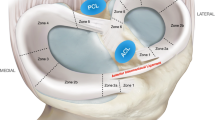Abstract
Purpose
To evaluate the magnetization transfer ratio (MTR) after two different cartilage repair procedures, and to compare these data with the MTR of normal cartilage.
Design and patients
Twenty-seven patients with a proven cartilage defect were recruited: 13 were treated with autologous chondrocyte implantation (ACI) and 14 were treated with the microfracture technique (MFR). All patients underwent MRI examinations with MT-sequences before the surgical treatment, after 12 months (26 patients) and after 24 months (11 patients). Eleven patients received a complete follow-up study at all three time points (five of the ACI group and six of the MFR group). All images were transferred to a workstation to calculate MTR images. For every MT image set, different ROIs were delineated by two radiologists. Means were calculated per ROI type in the different time frames and in both groups of cartilage repair. The data were analyzed with unpaired t- and ANOVA tests, and by calculating Pearson’s correlation coefficient.
Results
No significant differences were found in the MTR of fatty bone marrow, muscle and normal cartilage in the different time frames. There was a significant but small difference between the MTR of normal cartilage and the cartilage repair area after 12 months for both procedures. After 24 months, the MTR of ACI repaired cartilage (0.31±0.07) was not significantly different from normal cartilage MTR (0.34±0.05). The MTR of MFR repaired cartilage (0.28±0.02), still showed a significant difference from normal cartilage.
Conclusion
The differences between damaged and repaired cartilage MTR are too small to enable MT-imaging to be a useful tool for postoperative follow-up of cartilage repair procedures. There is, however, an evolution towards normal MTR-values in the cartilage repair tissue (especially after ACI repair).


Similar content being viewed by others
References
Cooper C. Occupational activity and the risk of osteoarthritis. J Rheumatol 1995;43:10–12
Brittberg M, Lindahl A, Nilsson A, Ohlsson C, Isaksson O, Peterson L. Treatment of deep cartilage defects in the knee with autologous chondrocyte transplantation. N Engl J Med 1994;331:889–895
Steadman JR, Rodkey WG, Briggs KK. Microfracture to treat full-thickness chondral defects: surgical technique, rehabilitation, and outcomes. J Knee Surg 2002;15:170–176
Knutsen G, Engebretsen L, Ludvigsen TC et al. Autologous chondrocyte implantation compared with microfracture in the knee. A randomized trial. J Bone Joint Surg Am 2004;86:455–464
Disler DG, McCauley TR, Kelman CG et al. Fat-suppressed three-dimensional spoiled gradient echo MR imaging of hyaline cartilage defects in the knee: comparison with standard MR imaging and arthroscopy. AJR Am J Roentgenol 1996;167:127–132
Bredella MA, Tirman PF, Peterfy CG et al. Accuracy of T2 weighted fast spin echo MR imaging with fat saturation in detecting cartilage defects in the knee: comparison with arthroscopy in 130 patients. AJR Am J Roentgenol 1999;172:1073–1080
Tins BJ, McCall IW, Takahashi T et al. Autologous chondrocyte implantation in knee joint: MR imaging and histologic features at 1-year follow-up. Radiology 2005;234:501–508
Morris GA, Freemont AJ. Direct observation of the magnetization exchange dynamics responsible for magnetization transfer contrast in human cartilage in vitro. Magn Reson Med 1992;28:97–104
Wachsmuth L, Juretschke HP, Raiss RX. Can magnetization transfer magnetic resonance imaging follow proteoglycan depletion in articular cartilage? MAGMA 1997;5:71–78
Ceckler TL, Wolff SD, Yip V, Simon SA, Balaban RS. Dynamic and chemical factors affecting water proton relaxation by macromolecules. J Magn Reson 1992;98:637–645
Kim DK, Ceckler TL, Hascall VC, Calabro A, Balaban RS. Analysis of water-macromolecule proton magnetization transfer in articular cartilage. Magn Reson Med 1993;29:211–215
Gray ML, Burstein D, Lesperance LM, Gehrke L. Magnetization transfer in cartilage and its constituent macromolecules. Magn Reson Med 1995;34:319–325
Lattanzio PJ, Marshall KW, Damyanovich AZ, Peemoeller H. Macromolecule and water magnetization exchange modeling in articular cartilage. Magn Reson Med 2000;44:840–851
Wolff SD, Balaban RS. Magnetization transfer imaging: practical aspects and clinical applications. Radiology 1994;192:593–599
Dardzinski BJ, Mosher TJ, Li S, Van Slyke MA, Smith MB. Spatial variation of T2 in human articular cartilage. Radiology 1997;205:546–550
Frank LR, Wong EC, Luh WM, Ahn JM, Resnick D. Articular cartilage in the knee: mapping of the physiologic parameters at MR imaging with a local gradient coil-preliminary results. Radiology 1999;210:241–246
Mosher TJ, Dardzinski BJ, Smith MB. Human articular cartilage: influence of aging and early symptomatic degeneration on the spatial variation of T2-preliminary findings at 3 T. Radiology 2000;214:259–266
Nieminen MT, Rieppo J, Toyras J et al. T2 relaxation reveals spatial collagen architecture in articular cartilage: a comparative quantitative MRI and polarized light microscopic study. Magn Reson Med 2001;46:487–493
Goodwin DW, Zhu H, Dunn JF. In vitro MR imaging of hyaline cartilage: correlation with scanning electron microscopy. AJR Am J Roentgenol 2000;174:405–409
Grunder W, Wagner M, Werner A. MR-microscopic visualization of anisotropic internal cartilage structures using the magic angle technique. Magn Reson Med 1998;39:376–382
Cova M, Toffanin R, Frezza F et al. Magnetic resonance imaging of articular cartilage: ex vivo study on normal cartilage correlated with magnetic resonance microscopy. Eur Radiol 1998;8:1130–1136
Seo GS, Aoki J, Moriya H et al. Hyaline cartilage: in vivo and in vitro assessment with magnetization transfer imaging. Radiology 1996;201:525–530
Hohe J, Faber S, Stammberger T, Reiser M, Englmeier KH, Eckstein F. A technique for 3D in vivo quantification of proton density and magnetization transfer coefficients of knee joint cartilage. Osteoarthritis Cartilage 2000;8:426–433
Henkelman RM. Magnetization transfer in MRI: a review. MR in Biomedicine 2001;14:57–64
Author information
Authors and Affiliations
Corresponding author
Rights and permissions
About this article
Cite this article
Palmieri, F., De Keyzer, F., Maes, F. et al. Magnetization transfer analysis of cartilage repair tissue: a preliminary study. Skeletal Radiol 35, 903–908 (2006). https://doi.org/10.1007/s00256-006-0146-9
Received:
Revised:
Accepted:
Published:
Issue Date:
DOI: https://doi.org/10.1007/s00256-006-0146-9




